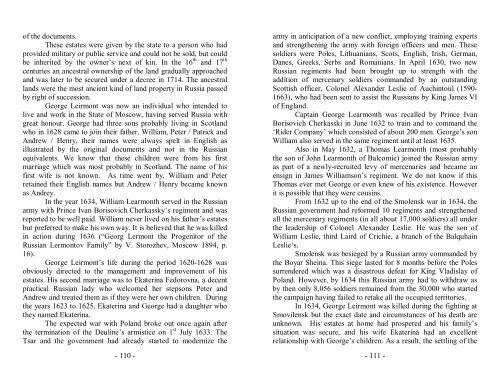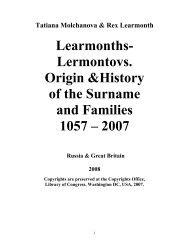LEARMONTH-LERMONTOV. A HYISTORY OF THE NAME AND FAMILIES
By Tatiana Molchanova and Rex Learmonth, 2011
By Tatiana Molchanova and Rex Learmonth, 2011
- No tags were found...
Create successful ePaper yourself
Turn your PDF publications into a flip-book with our unique Google optimized e-Paper software.
of the documents.<br />
These estates were given by the state to a person who had<br />
provided military or public service and could not be sold, but could<br />
be inherited by the owner’s next of kin. In the 16 th and 17 th<br />
centuries an ancestral ownership of the land gradually approached<br />
and was later to be secured under a decree in 1714. The ancestral<br />
lands were the most ancient kind of land property in Russia passed<br />
by right of succession.<br />
George Leirmont was now an individual who intended to<br />
live and work in the State of Moscow, having served Russia with<br />
great honour. George had three sons probably living in Scotland<br />
who in 1628 came to join their father. William, Peter / Patrick and<br />
Andrew / Henry, their names were always spelt in English as<br />
illustrated by the original documents and not in the Russian<br />
equivalents. We know that these children were from his first<br />
marriage which was most probably in Scotland. The name of his<br />
first wife is not known. As time went by, William and Peter<br />
retained their English names but Andrew / Henry became known<br />
as Andrey.<br />
In the year 1634, William Learmonth served in the Russian<br />
army with Prince Ivan Borisovich Cherkassky’s regiment and was<br />
reported to be well paid. William never lived on his father’s estates<br />
but preferred to make his own way. It is believed that he was killed<br />
in action during 1636 (“Georg Lermont the Progenitor of the<br />
Russian Lermontov Family” by V. Storozhev, Moscow 1894, p.<br />
16).<br />
George Leirmont’s life during the period 1620-1628 was<br />
obviously directed to the management and improvement of his<br />
estates. His second marriage was to Ekaterina Fedorovna, a decent<br />
practical Russian lady who welcomed her stepsons Peter and<br />
Andrew and treated them as if they were her own children. During<br />
the years 1623 to 1625, Ekaterina and George had a daughter who<br />
they named Ekaterina.<br />
The expected war with Poland broke out once again after<br />
the termination of the Deuline’s armistice on 1 st July 1633. The<br />
Tsar and the government had already started to modernize the<br />
- 110 -<br />
army in anticipation of a new conflict, employing training experts<br />
and strengthening the army with foreign officers and men. These<br />
soldiers were Poles, Lithuanians, Scots, English, Irish, German,<br />
Danes, Greeks, Serbs and Romanians. In April 1630, two new<br />
Russian regiments had been brought up to strength with the<br />
addition of mercenary soldiers commanded by an outstanding<br />
Scottish officer, Colonel Alexander Leslie of Auchintoul (1590-<br />
1663), who had been sent to assist the Russians by King James VI<br />
of England.<br />
Captain George Learmonth was recalled by Prince Ivan<br />
Borisovich Cherkasski in June 1632 to train and to command the<br />
‘Rider Company’ which consisted of about 200 men. George’s son<br />
William also served in the same regiment until at least 1635.<br />
Also in May 1632, a Thomas Learmonth (most probably<br />
the son of John Learmonth of Balcomie) joined the Russian army<br />
as part of a newly-recruited levy of mercenaries and became an<br />
ensign in James Williamson’s regiment. We do not know if this<br />
Thomas ever met George or even knew of his existence. However<br />
it is possible that they were cousins.<br />
From 1632 up to the end of the Smolensk war in 1634, the<br />
Russian government had reformed 10 regiments and strengthened<br />
all the mercenary regiments (in all about 17,000 soldiers) all under<br />
the leadership of Colonel Alexander Leslie. He was the son of<br />
William Leslie, third Laird of Crichie, a branch of the Balquhain<br />
Leslie‘s.<br />
Smolensk was besieged by a Russian army commanded by<br />
the Boyar Sheina. This siege lasted for 8 months before the Poles<br />
surrendered which was a disastrous defeat for King Vladislay of<br />
Poland. However, by 1634 this Russian army had to withdraw as<br />
by then only 8,056 soldiers remained from the 30,000 who started<br />
the campaign having failed to retake all the occupied territories.<br />
In 1634, George Leirmont was killed during the fighting at<br />
Smovilensk but the exact date and circumstances of his death are<br />
unknown. His estates at home had prospered and his family’s<br />
situation was secure, and his wife Ekaterina had an excellent<br />
relationship with George’s children. As a result, the settling of the<br />
- 111 -






